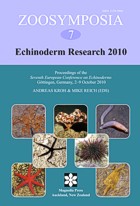Abstract
In species of the family Heliasteridae, the ossicles of the proximal parts of the sides of each ray are joined by connective tissue to those of the adjacent rays to form interradial septa. These provide support to the extensive disc. Only a relatively small part of the ray is free. Autotomy of rays occurs in Heliaster helianthus in response to predatory attack by the asteroid Meyenaster gelatinosus. Autotomy of the ray does not occur at the base of the free part of the ray (arm) but near the base of the ray. In addition to the plane of autotomy at this location, a longitudinal plane of autotomy occurs in the connective tissue between the ossicles of the interradial septa. This indicates a plane of mutable collagenous tissue is present. Autotomy of the ray involves all these planes of autotomy and results in loss of most of the ray.

